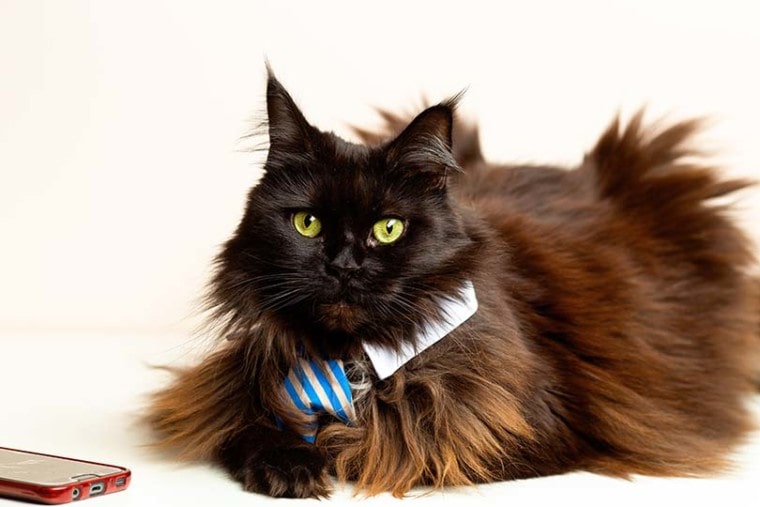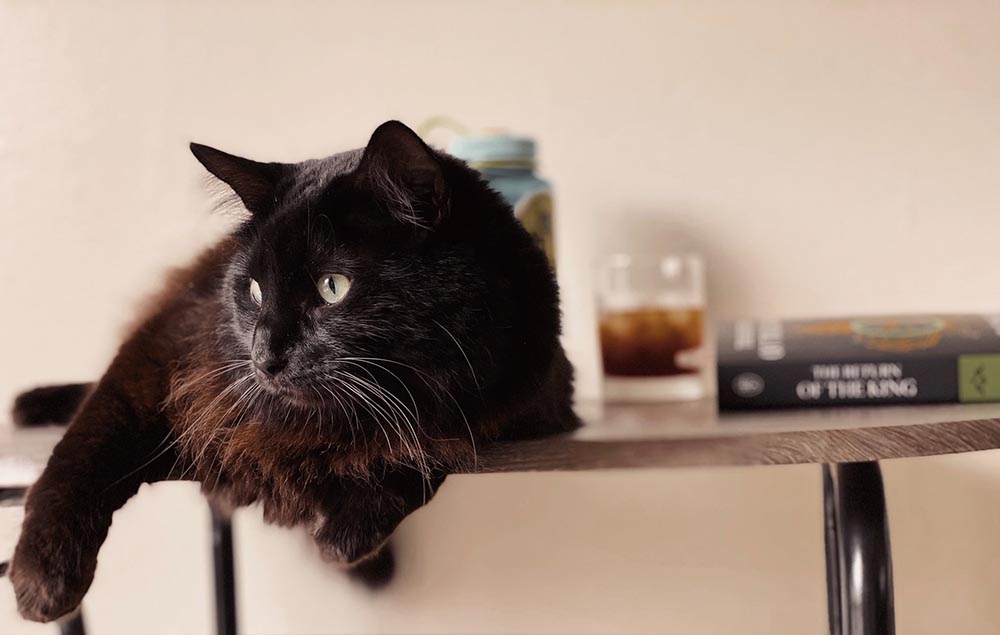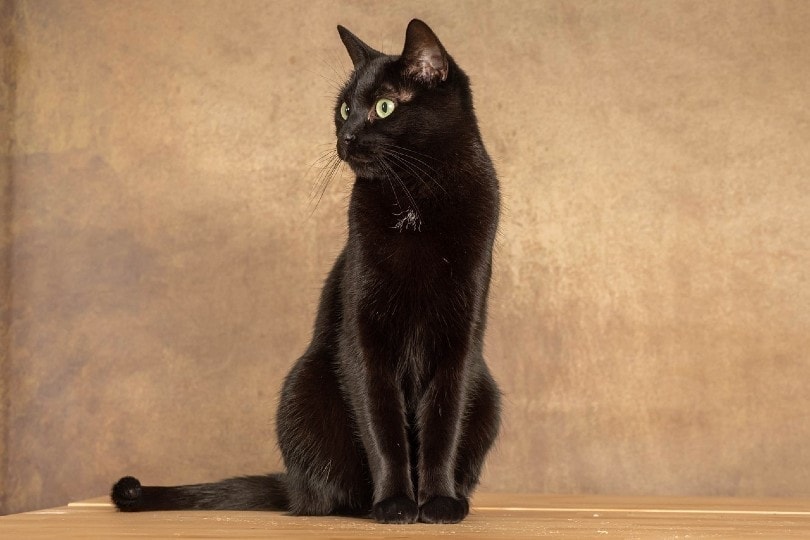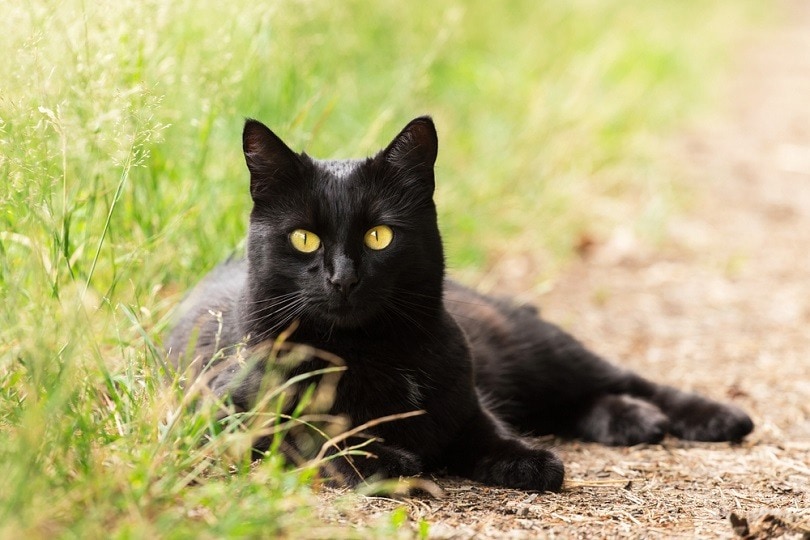
Known for being good luck in some cultures, black cats are truly beautiful and mysterious. There are numerous tales and stories about black cats from ancient times and some of them relate to that special time of year called Halloween. Black cats are thought to be wise and connected to the spirit world and Salem from the Sabrina the Teenage Witch comic book series and TV show is a good, rather funny example!
So, if you are reading this, you are wondering why your little black delight is morphing into a different colored cat. Cats come in all shapes, colors, and sizes, and their skin or coat can change over time.
If your kitty is showing other unusual signs in addition to coat discoloration, be sure to take them to the vet for a checkup. Now let’s cover the potential reasons for a color change from black to brown or any lighter shade in your cat.

The 6 Reasons Your Cat’s Coat Color May Lighten
1. Nutrition and Overall Well-Being
A common reason for your black cat’s fur to change is related to their diet and health. Like humans, cats have the color pigment melanin present in their skin and coat. Melanin is responsible for your kitty’s hair color and style, and the amount is transferred via the genetic makeup of the mom and dad cat at conception. At birth, the kitten’s hair color is a combination of both parents, and this is unique for each cat. There is a lot of science that goes into making melanin in the body of a feline, but we’ll go over the essentials.
Tyrosine
Let’s start with amino acids, which are the building blocks of all proteins in the animal kingdom (and the plant world too). Cats require 11 essential amino acids, nine of which humans also require, but additionally arginine and taurine. Most high-quality pet food will either contain these naturally or have fortifications, such as taurine, to ensure the proper daily requirement is met.
Phenylalanine is one of these indispensable amino acids and half of its intake goes into its conversion into tyrosine. This conversion takes place in the liver and tyrosine can be hence converted again to dopamine, thyroxine melanin, and other compounds. Phenylalanine is found in a variety of sources, primarily meat, eggs, and dairy. If your cat’s diet is not sufficient in this amino acid, then melanin production is decreased, and their coat may start to discolor.
There has been detailed research about the effects of this and the specific dietary requirements to support adequate tyrosine for melanin production. You must consult your vet before giving your kitty any tyrosine supplements as this may have negative health effects. Studies seem to indicate that high levels of phenylalanine are not toxic, but it is common sense to never overfeed your cat to improve its coat! If you are giving your kitty clan a balanced diet of meat and fish in a combination of wet and dry foods, then they are more than likely getting enough protein to maintain melanin levels.
2. Illness
On a more serious note, changes in a cat’s coat can indicate a deeper health issue. As we discovered, tyrosine is created in the liver, so a coat turning to a lighter shade may mean that the liver function is not optimal.
Tyrosine also helps the production of a hormone called thyroxine in the thyroid gland. The thyroid gland’s main function is to regulate your feline’s metabolism. So, if you notice any weight changes, lethargy, or hyperactivity, consult your vet as this may be the cause of the fur transformation.
Too much zinc or copper deficiency can also be the cause. A full blood test and further investigation by your vet should provide a specific diagnosis and treatment.

3. Genetics
Just like the red hair gene in humans, the black hair gene in cats is specific, although maybe not as rare. There is a full spectrum of possibilities for variations to the pure black coat with tints of red, copper, burgundy, and orange. It may be that these gene expressions reveal that one of the cat’s parents was a little bit tabby or bronze colored. Whatever mixture of tones your kitty is, they are very special!
4. Physical Maturing
Certain genes may only express themselves at a particular age and so this may explain the sudden onset of a “dyed” feline. Grey-haired humans are a normal sight, and in cats, it is not any different. As they get wiser and better at catching mice, their hair color may begin to lighten to random tones. Perhaps they would go to the cat hairdresser for highlights if they could, but most remain natural and let their hair and age change as time goes on!

5. Sunshine
Everybody knows how much cats love the heat. Being by the fire or sunbathing is heaven for our feline friends! Perhaps a cat’s version of tanning is when their coat turns lighter as a result of the sun, which is a bona fide thing in the feline world. If your cat has been lounging in the garden all day or spending hours in the sun by the window, then that explains their fur change. Please note that excessive sun exposure has been linked to certain cancers in cats, such as squamous cell carcinoma.
6. Thermo-Sensitivity
Some cat breeds change color in different temperatures and climates. This is due to the fact that the tyrosine, when formed, is heat sensitive. Certain breeds, such as Himalayan cat types, have this modification. Siamese cats tend to get darker in the winter, and when summer rolls around, their coat returns to a lighter shade. It is quite possible that your cat is a hybrid breed and so possesses some of this thermo-sensitivity.
Again, even though most of the possibilities are nothing to worry about, it is always best to explore things fully with your vet, just in case a new hairdo represents more than just a style change for your cat.


Conclusion
A black cat’s coat may change color for several reasons. Some are natural responses to age and their genetics, while others might hint at an underlying health issue or a dietary insufficiency. If you’re in doubt about your cat’s fur coat’s color change, it’s best to consult with your veterinarian to ensure that the change is natural and not due to an illness or ailment.
- Related Read: Are Brown Cats Rare?
Featured Image Credit: nuclear_lily, Shutterstock






